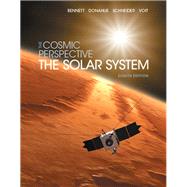For two-semester courses in astronomy.
Teaching the Process of Science through Astronomy
Building on a long tradition of effective pedagogy and comprehensive coverage, The Cosmic Perspective: The Solar System, Eighth Edition provides a thoroughly engaging and up-to-date introduction to astronomy for non-science majors. This text offers a wealth of features that enhance student understanding of the process of science and actively engage students in the learning process for key concepts. The fully updated Eighth Edition includes the latest scientific discoveries, revises several subjects based on our most current understanding of the cosmos, and now emphasizes deeper understanding of the twists and turns of the process of science and the relevance of concepts to student’s lives.
The text is supported by a robust package of instructor and student ancillaries, including MasteringAstronomy. This market-leading online tutorial and homework system has been updated with new content that helps students learn and review more effectively outside of class.
- The Cosmic Perspective: The Solar System, Eighth Edition includes Chapters 1–13, 14, S1, 24.
Also available with MasteringAstronomy
MasteringAstronomy from Pearson is the leading online homework, tutorial, and assessment system, designed to improve results by engaging students before, during, and after class with powerful content. Instructors ensure students arrive ready to learn by assigning educationally effective content before class, and encourage critical thinking and retention with in-class resources. Students can further master concepts after class through homework assignments that provide interactivity, hints and answer-specific feedback. The Mastering gradebook records scores for all automatically graded assignments in one place, while diagnostic tools give instructors access to rich data to assess student understanding and misconceptions.
Mastering brings learning full circle by continuously adapting to each student and making learning more personal than ever—before, during, and after class.
Note: You are purchasing a standalone product; MasteringAstronomy does not come packaged with this content. Students, if interested in purchasing this title with MasteringAstronomy, ask your instructor for the correct package ISBN and Course ID. Instructors, contact your Pearson representative for more information.









